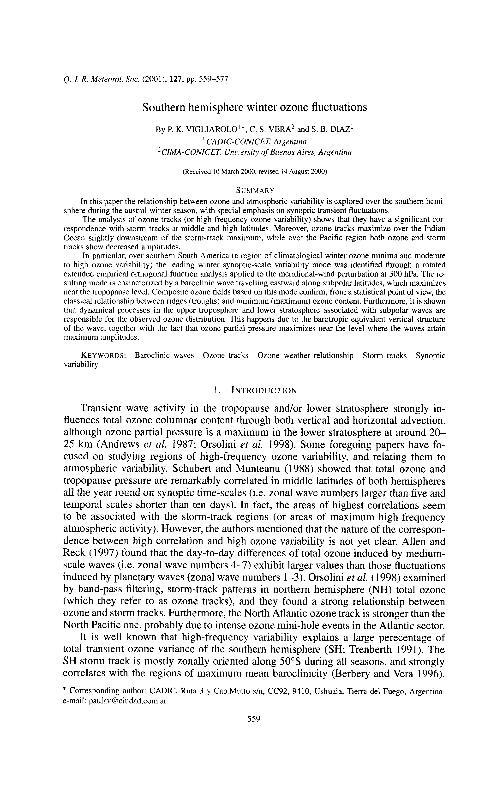Mostrar el registro sencillo del ítem
dc.contributor.author
Vigliarolo, Paula Karina

dc.contributor.author
Vera, Carolina Susana

dc.contributor.author
Diaz, S. B.
dc.date.available
2021-11-26T15:32:15Z
dc.date.issued
2001-01
dc.identifier.citation
Vigliarolo, Paula Karina; Vera, Carolina Susana; Diaz, S. B.; Southern hemisphere winter ozone fluctuations; John Wiley & Sons Ltd; Quarterly Journal of the Royal Meteorological Society; 127; 572; 1-2001; 559-577
dc.identifier.issn
0035-9009
dc.identifier.uri
http://hdl.handle.net/11336/147517
dc.description.abstract
In this paper the relationship between ozone and atmospheric variability is explored over the southern hemisphere during the austral winter season, with special emphasis on synoptic transient fluctuations. The analysis of ozone tracks (or high-frequency ozone variability) shows that they have a significant correspondence with storm tracks at middle and high latitudes. Moreover, ozone tracks maximize over the Indian Ocean slightly downstream of the storm-track maximum, while over the Pacific region both ozone and storm tracks show decreased amplitudes.In particular, over southern South America (a region of climatological winter ozone minima and moderate to high ozone variability) the leading winter synoptic-scale variability mode was identified through a rotated extended empirical orthogonal function analysis applied to the meridional-wind perturbation at 300 hPa. The resulting mode is characterized by a baroclinic wave travelling eastward along subpolar latitudes, which maximizes near the tropopause level. Composite ozone fields based on this mode confirm, from a statistical point of view, the classical relationship between ridges (troughs) and minimum (maximum) ozone content. Furthermore, it is shown that dynamical processes in the upper troposphere and lower stratosphere associated with subpolar waves are responsible for the observed ozone distribution. This happens due to the barotropic equivalent vertical structure of the wave, together with the fact that ozone partial pressure maximizes near the level where the waves attain maximum amplitudes.
dc.format
application/pdf
dc.language.iso
eng
dc.publisher
John Wiley & Sons Ltd

dc.rights
info:eu-repo/semantics/openAccess
dc.rights.uri
https://creativecommons.org/licenses/by-nc-sa/2.5/ar/
dc.subject
SOUTHERN
dc.subject
HEMISPHERE
dc.subject
WINTER
dc.subject
OZONE
dc.subject
FLUCTUATIONS
dc.subject.classification
Meteorología y Ciencias Atmosféricas

dc.subject.classification
Ciencias de la Tierra y relacionadas con el Medio Ambiente

dc.subject.classification
CIENCIAS NATURALES Y EXACTAS

dc.title
Southern hemisphere winter ozone fluctuations
dc.type
info:eu-repo/semantics/article
dc.type
info:ar-repo/semantics/artículo
dc.type
info:eu-repo/semantics/publishedVersion
dc.date.updated
2021-01-18T21:03:46Z
dc.identifier.eissn
1477-870X
dc.journal.volume
127
dc.journal.number
572
dc.journal.pagination
559-577
dc.journal.pais
Reino Unido

dc.journal.ciudad
Londres
dc.description.fil
Fil: Vigliarolo, Paula Karina. Consejo Nacional de Investigaciones Científicas y Técnicas. Centro Austral de Investigaciones Científicas; Argentina
dc.description.fil
Fil: Vera, Carolina Susana. Consejo Nacional de Investigaciones Científicas y Técnicas. Oficina de Coordinación Administrativa Ciudad Universitaria. Centro de Investigaciones del Mar y la Atmósfera. Universidad de Buenos Aires. Facultad de Ciencias Exactas y Naturales. Centro de Investigaciones del Mar y la Atmósfera; Argentina
dc.description.fil
Fil: Diaz, S. B.. Universidad de Buenos Aires. Facultad de Ciencias Exactas y Naturales. Centro de Investigaciones del Mar y la Atmósfera; Argentina
dc.journal.title
Quarterly Journal of the Royal Meteorological Society

dc.relation.alternativeid
info:eu-repo/semantics/altIdentifier/doi/http://dx.doi.org/10.1002/qj.49712757216
dc.relation.alternativeid
info:eu-repo/semantics/altIdentifier/url/https://rmets.onlinelibrary.wiley.com/doi/abs/10.1002/qj.49712757216
Archivos asociados
